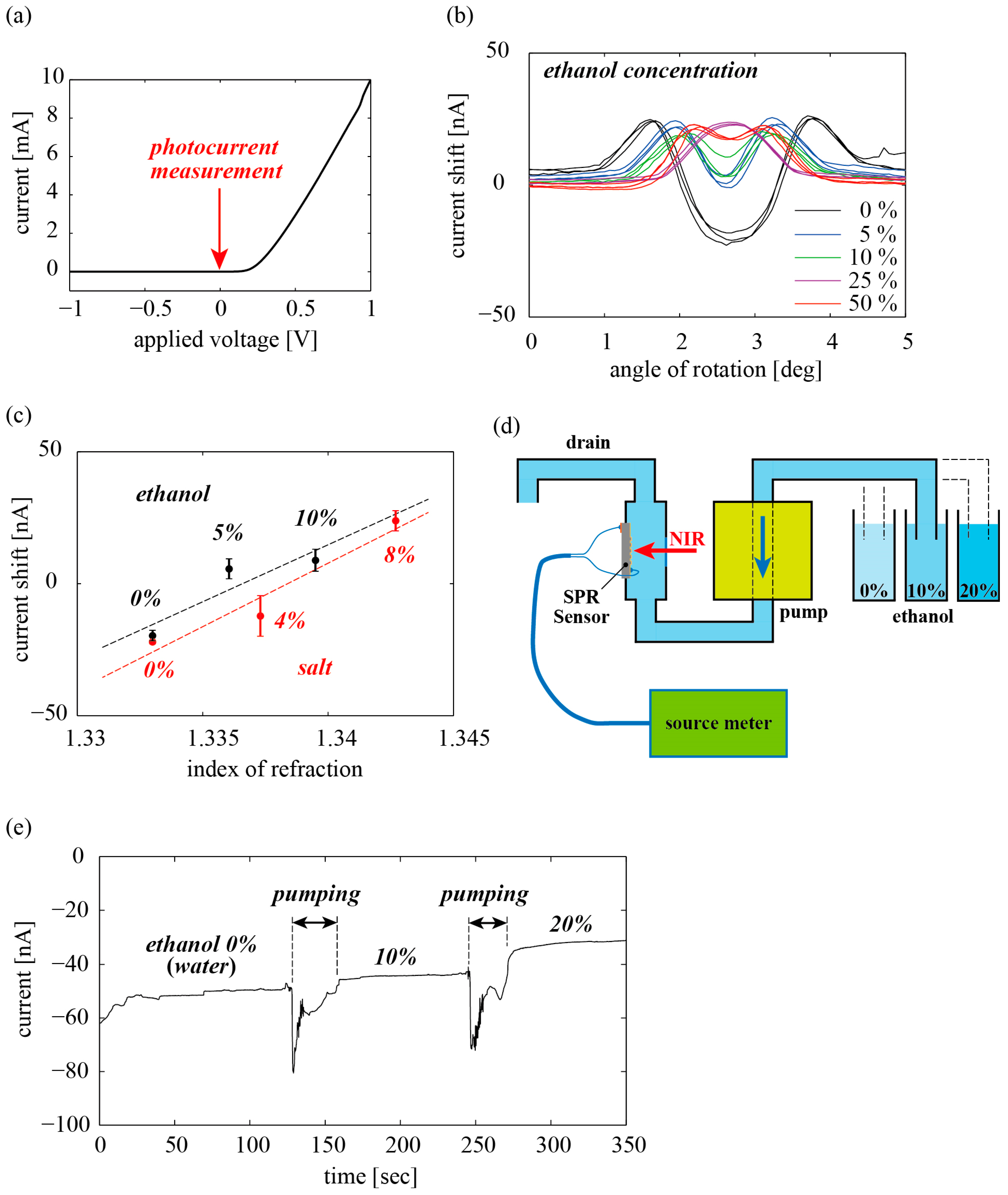Compact Surface Plasmon Resonance System with Au/Si Schottky Barrier
Abstract
:1. Introduction
2. Materials and Methods
3. Results
4. Discussion
Acknowledgments
Author Contributions
Conflicts of Interest
References
- Ritchie, R.H. Plasma losses by fast electrons in thin films. Phys. Rev. 1957, 106, 874–881. [Google Scholar] [CrossRef]
- Fischer, U.C.; Pohl, D.W. Observation of single-particle plasmons by near-field optical microscopy. Phys. Rev. Lett. 1989, 62, 458–461. [Google Scholar] [CrossRef] [PubMed]
- Berthold, K.; Höpfel, R.A.; Gornik, E. Surface plasmon polariton enhanced photoconductivity of tunnel junctions in the visible. Appl. Phys. Lett. 1985, 46, 626–628. [Google Scholar] [CrossRef]
- Brueck, S.R.J.; Diadiuk, V.; Jones, T.; Lenth, W. Enhanced quantum efficiency internal photoemission detectors by grating coupling to surface plasma waves. Appl. Phys. Lett. 1985, 46, 915–917. [Google Scholar] [CrossRef]
- Nylander, C.; Liedberg, B.; Lind, T. Gas detection by means of surface plasmon resonance. Sens. Actuators 1982, 3, 79–88. [Google Scholar] [CrossRef]
- Liedberg, B.; Nylander, C.; Lunström, I. Suface plasmon resonance for gas detection and biosensing. Sens. Actuators 1983, 4, 299–304. [Google Scholar] [CrossRef]
- Rothenhäusler, B.; Knoll, W. Surface-plasmon microscopy. Nature 1988, 332, 615–617. [Google Scholar] [CrossRef]
- Tamada, K.; Ishida, T.; Knoll, W.; Fukushima, H.; Colorado, R.; Graupe, M.; Shmakova, O.E.; Lee, T.R. Molecular packing of semifluorinated alkanethiol self-assembled monolayers on gold: Influence of alkyl spacer length. Langmuir 2001, 17, 1913–1921. [Google Scholar] [CrossRef]
- Homola, J. Surface plasmon resonans sensors for detection of chemical and biological species. Chem. Rev. 2008, 108, 462–493. [Google Scholar] [CrossRef] [PubMed]
- Liebermann, T.; Knoll, W.; Sluka, P.; Herrmann, R. Complement hybridization from solution to surface-attached probe-oligonucleotides observed by surface-plasmon-field-enhanced fluorescence spectroscopy. Colloids Surf. A 2000, 169, 337–350. [Google Scholar] [CrossRef]
- Xu, H.; Bjerneld, E.J.; Käll, M.; Börjesson, L. Spectroscopy of single hemoglobin molecules by surface enhanced raman scattering. Phys. Rev. Lett. 1999, 83, 4357–4360. [Google Scholar] [CrossRef]
- Pendry, J.B. Negative refraction makes a perfect lens. Phys. Rev. Lett. 2000, 85, 3966–3969. [Google Scholar] [CrossRef] [PubMed]
- Fang, N.; Lee, H.; Sun, C.; Zhang, X. Sub-diffraction-limited optical imaging with a silver superlens. Science 2005, 308, 534–538. [Google Scholar] [CrossRef] [PubMed]
- Mauriz, E.; Calle, A.; Montoya, A.; Lechuga, L.M. Determination of environmental organic pollutants with a portable optical immunosensor. Talanta 2006, 69, 359–364. [Google Scholar] [CrossRef] [PubMed]
- Connolly, P.W.R.; Kaplan, A. Demonstrating the angular, wavelength and polarization dependence of surface plasmon resonance on thin gold films—An undergraduate experiment. Am. J. Phys. 2016, 84, 775–779. [Google Scholar] [CrossRef]
- Clavero, C. Plasmon-induced hot-electron generation at nanoparticle/metal-oxide interfaces for photovoltaic and photocatalytic devices. Nat. Photonics 2014, 8, 95–103. [Google Scholar] [CrossRef]
- Sobhani, A.; Knight, M.W.; Wang, Y.; Zheng, B.; King, N.S.; Brown, L.V.; Fang, Z.; Nordlander, P.; Halas, N.J. Narrowband photodetection in the near-infrared with a plasmon-induced hot electron device. Nat. Commun. 2013, 4, 1643. [Google Scholar] [CrossRef] [PubMed]
- Chen, W.; Kan, T.; Ajiki, Y.; Matsumoto, K.; Shimoyama, I. Nir spectrometer using a schottky photodetector enhanced by grating-based spr. Opt. Express 2016, 24, 25797–25804. [Google Scholar] [CrossRef] [PubMed]
- Kan, T.; Matsumoto, K.; Shimoyama, I. Tunable gold-coated polymer gratings for surface plasmon resonance coupling and scanning. J. Micromech. Microeng. 2010, 20, 085032. [Google Scholar] [CrossRef]
- Raether, H. Surface Plasmons on Smooth and Rough Surfaces and on Grating; Springer: Berlin, Germany, 1988. [Google Scholar]
- Johnson, P.B.; Christy, R.W. Optical constants of the noble metals. Phys. Rev. B 1972, 6, 4371–4379. [Google Scholar] [CrossRef]
- bin Mat Yunus, W.M.; bin Abdul Rahman, A. Refractive index of solutions at high concentrations. Appl. Opt. 1988, 27, 3341–3343. [Google Scholar] [CrossRef]
- Cheung, S.K.; Cheung, N.W. Extraction of schottky diode parameters from forward current-voltage characteristics. Appl. Phys. Lett. 1986, 49, 85–87. [Google Scholar] [CrossRef]
- Nowakowska, J. The Refractive Indices of Ethyl Alcohol and Water Mixtures. Master’s Thesis, Loyola University, Chicago, IL, USA, 1939. [Google Scholar]



© 2018 by the authors. Licensee MDPI, Basel, Switzerland. This article is an open access article distributed under the terms and conditions of the Creative Commons Attribution (CC BY) license (http://creativecommons.org/licenses/by/4.0/).
Share and Cite
Tsukagoshi, T.; Kuroda, Y.; Noda, K.; Binh-Khiem, N.; Kan, T.; Shimoyama, I. Compact Surface Plasmon Resonance System with Au/Si Schottky Barrier. Sensors 2018, 18, 399. https://doi.org/10.3390/s18020399
Tsukagoshi T, Kuroda Y, Noda K, Binh-Khiem N, Kan T, Shimoyama I. Compact Surface Plasmon Resonance System with Au/Si Schottky Barrier. Sensors. 2018; 18(2):399. https://doi.org/10.3390/s18020399
Chicago/Turabian StyleTsukagoshi, Takuya, Yuta Kuroda, Kentaro Noda, Nguyen Binh-Khiem, Tetsuo Kan, and Isao Shimoyama. 2018. "Compact Surface Plasmon Resonance System with Au/Si Schottky Barrier" Sensors 18, no. 2: 399. https://doi.org/10.3390/s18020399
APA StyleTsukagoshi, T., Kuroda, Y., Noda, K., Binh-Khiem, N., Kan, T., & Shimoyama, I. (2018). Compact Surface Plasmon Resonance System with Au/Si Schottky Barrier. Sensors, 18(2), 399. https://doi.org/10.3390/s18020399




